The Chronicle of Anna Magdalena Bach (1968) by Jean-Marie Straub and Danièle Huillet is a film almost unlike any other. Starring classical harpsichordist Gustav Leonhardt as Bach, the film tracks the composer through his everyday life as a church organist and composer for hire, and is composed of only about 80 shots for the entire film. Filmed on many of the actual locations of Bach’s life, using period musical instruments, real musicians rather than actors pretending to be musicians, and photographed in 35mm using direct sync-sound recording, the film is truly a one of a kind project. Though Straub is often credited as the sole director of the film, it’s clear to me that it was co-directed by both Straub and Huillet, as a documentary on the making of the film demonstrates.
The Chronicle of Anna Magdalena Bach is a film about the difficulty of being an artist in an often indifferent world; of having to work to support a family; about Anna’s thirteen children with Bach, seven of whom died in childhood; and their lives together, as musicians and marital partners. It’s also a film that not only captures, with stunning authenticity, the period of late 17th and early 18th century Germany, but also the era in which it was created; the late 1960s, a period of intense cultural and artistic ferment. The overall effect is transcendent – one feels that one is in the room with Bach and his wife Anna (Christiane Lang), present at the creation of some of the most gorgeous music that the world has ever known.
Interestingly, The Chronicle of Anna Magdalena Bach was to have been shot in color, using direct sound recording (as it has in the completed version). However, three days before filming was to begin, the Italian producer of the film, Gian Vittorio Baldi, told Straub that he would only agree to proceed with shooting if Straub post-synced the film, using the same musicians, but re-recording them in the studio, to obtain supposedly ‘optimal’ sound. Needless to say, such a move would have completely undermined the artistic integrity — to say nothing of the sense of verisimilitude — that pervades the final film, in addition to doing away with the acoustic values inherent in location shooting and live sound recording.
It was only when the unlikely figure of Jean-Luc Godard stepped in with some funding, along with the German government, that filming was allowed to proceed; the film then had to be shot in black and white because of the reduced budget. I think it actually works better in black and white, and becomes more pleasingly austere, like a series of line engravings from the period, accompanied as it is with fragments of Bach’s letters and scores shown on the screen for brief segments along with his stunning music.
Straub and Huillet were working on such a limited budget that they had to scout locations for the film on bicycle, and arrange for the loan of authentic period costumes, instruments, and obtain filming permissions entirely on their own. The shooting was precise, but constrained by an extremely tight budget, and other than actual locations, the sets are minimal, dominated by Leonhardt’s authoritative performance as Bach, which is at once remote and yet absolutely present.
Straub and Huillet’s rigorousness in the construction of the film has put off many viewers, but the long takes, coupled with judicious tracking shots executed at just the right moment within each scene, bring the music to foreground of the work, rather than making Bach’s work subservient to the image. Then, too, by shooting on location, one gets a sense of timelessness in the work, which bursts with interpolated images of nature – meadows and the exterior world seen though windows, punctuated by long static shots of trees blowing in the wind – linking Bach’s music to the natural world around it.
At the same time, The Chronicle of Anna Magdalena Bach is continually and insistently about the hardships of daily existence; when we first encounter Bach in the film, he has a job as a court composer that he thoroughly enjoys, but through a series of circumstances is reduced to being little more than a church organist – at least as far as the rest of the world is concerned – who also has a heavy workload of composing new material on a weekly basis.
There is also the fact that the film mixes fact and fiction with abandon; Anna Magdalena’s supposed “chronicle” is actually a construct, and though it accurately depicts the domestic and professional struggles the couple faced – the death of several of their children, the constant worry about bills and debts, altercations with authority figures who attempt to rein in Bach’s musical output, and undermine his authority – it is a text created specifically for the film, and not an authentic talisman of the past.
Much has been made of the supposed mathematical precision of the film, but instead, I would argue that the visual structure of The Chronicle of Anna Magdalena Bach is more accurately informed by a high degree of Romanticism, austere though it may be. As Straub and Huillet maintained, the film is primarily a love story of their own creation; of Anna Magdalena’s love for Bach, and Bach’s love for music.
Framing the story through Anna’s eyes also serves an additional purpose; as Straub and Huillet noted, “we wanted to film a love story unlike any other: a woman talking about her husband whom she loved unto his death. That’s the story: no biography can be made without an external viewpoint, and here it is the consciousness of Anna Magdalena Bach”.1
When the film was screened at The New York Film Festival on 19 September 1968, there was something of a riot. The rigorousness of the film, and the fact that it insisted on such intense audience involvement with the image – one is compelled to search out every detail in the frame, simply as a matter of entering into Bach’s world – caused a number of otherwise thoughtful critics to dismiss the film as dry and lifeless, when it is anything but.
Indeed, The Chronicle of Anna Magdalena Bach has emerged as the most accessible of Straub and Huillet’s films, as we are transported to Bach’s era through the medium of the cinema as a kind of time machine, to the point where the screen almost seems to vanish. By cutting camera movement and shot structure down to a sculptural minimum, Straub and Huillet bring us to the heart of Bach’s music, without the artificial window dressing that mars more conventional films – for The Chronicle of Anna Magdalena Bach is indeed a radical piece of work.
It is also a deeply human document; the final shot of Leonhardt as Bach staring out of a window after a failed eye operation, which shortly thereafter brought about his death at the age of 65, is one of most simple and compelling codas one can imagine. The film is thus a glorious testament to the tenacious authenticity not only of Bach, but also the Straub and Huillet, who refused to compromise at any level in bringing their vision to the screen.
The Chronicle of Anna Magdalena Bach (1968 Germany 94 min)
|
Anna Magdalena Bach (= AMB) was the second wife of composer J.S. Bach, singer and chamber musician. She was born Anna Wilcken [Wülcken] in Zeitz, Saxony, into a musical family. Little is known of her career as a vocalist but she certainly knew J.S. Bach professionally at Köthen, where he was Kapellmeister from 1717. They married in December 1721, a year and a half after the death of the composer’s first wife, Maria Barbara Bach, and settled in Leipzig in 1723. The couple had 13 children, six of whom lived to adulthood, including future composers Johann Christoph Friedrich Bach [49] and Johann Christian Bach [50] (later known as “The London Bach”). Anna Magdalena Bach was an invaluable aide to J.S. Bach’s duties as Kantor of Leipzig, copying and transcribing the reams of music he wrote for the city’s five major churches; a number of his manuscripts exist only in her hand. J.S. Bach expressed his gratitude by dedicating several keyboard and chamber pieces to her, including the famous collection “The Little Notebook for Anna Magdalena Bach” (two volumes, 1722 and 1725), and organized informal concerts at their home so she could have a performing outlet. When J.S. Bach died in 1750, J.S. Bach left no will and his modest estate was evenly split between Anna Magdalena Bach and the nine surviving children from both marriages. If the subsequent neglect of J.S. Bach’s memory reflects scant credit on the Leipzig establishment, then the treatment of his widow reflects none at all. In 1751, church officials evicted Anna from the Kantor’s quarters she had called home for nearly 30 years, and she spent the rest of her life scraping by on charity. Why her able-bodied children did nothing to alleviate her poverty is not known. She died at 58 in an almshouse and was buried in an unmarked pauper’s grave at Leipzig’s Johanniskirche (St. John’s Church), where her husband had been laid to rest a decade before. J.S. Bach’s forgotten grave was discovered during renovation of the church in 1894, but Anna Magdalena’s was not and is now irretrievably lost – the Johanniskirche was destroyed by Allied bombing during World War II. In the 1960’s historians began to re-examine the role Anna played in J.S. Bach’s life and art, and today there are revisionists who claim she was the actual composer of some of his late music. She is also the subject of a fictionalized film, “The Chronicle of Anna Magdalena Bach” (1968). |
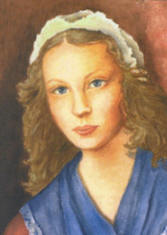 |
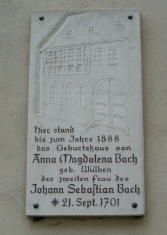 |
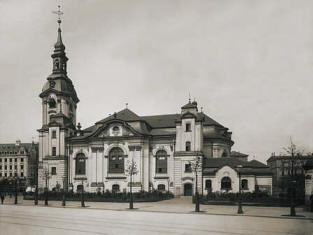 |
|
|
Anna Magdalena Bach [1] |
Bach Plaque on Geburtshaus von Anna Magdalena Bach, Zeitz [3] |
Leipzig‘s Johanniskirche in the early 1900’s. Originally a Gothic structure dating from the 16th Century, it was given a neo-Baroque remodel in the mid-1890s. Gutted by Allied bombs during World War II, the church was demolished in 1949 and its tower blown up in 1963. A park is now on the site. [2] |
|
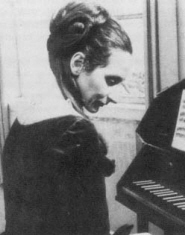 |
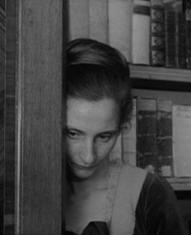 |
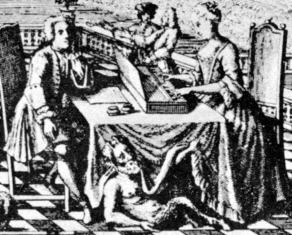 |
|
|
The Bachs at leisure? Johann Sebastian with his wife Anna Magdalena, 1736 [4] See: Memo-1309 |
Christiane Lang-Drewanz as Anna Magdalena Bach. [5] |
||
